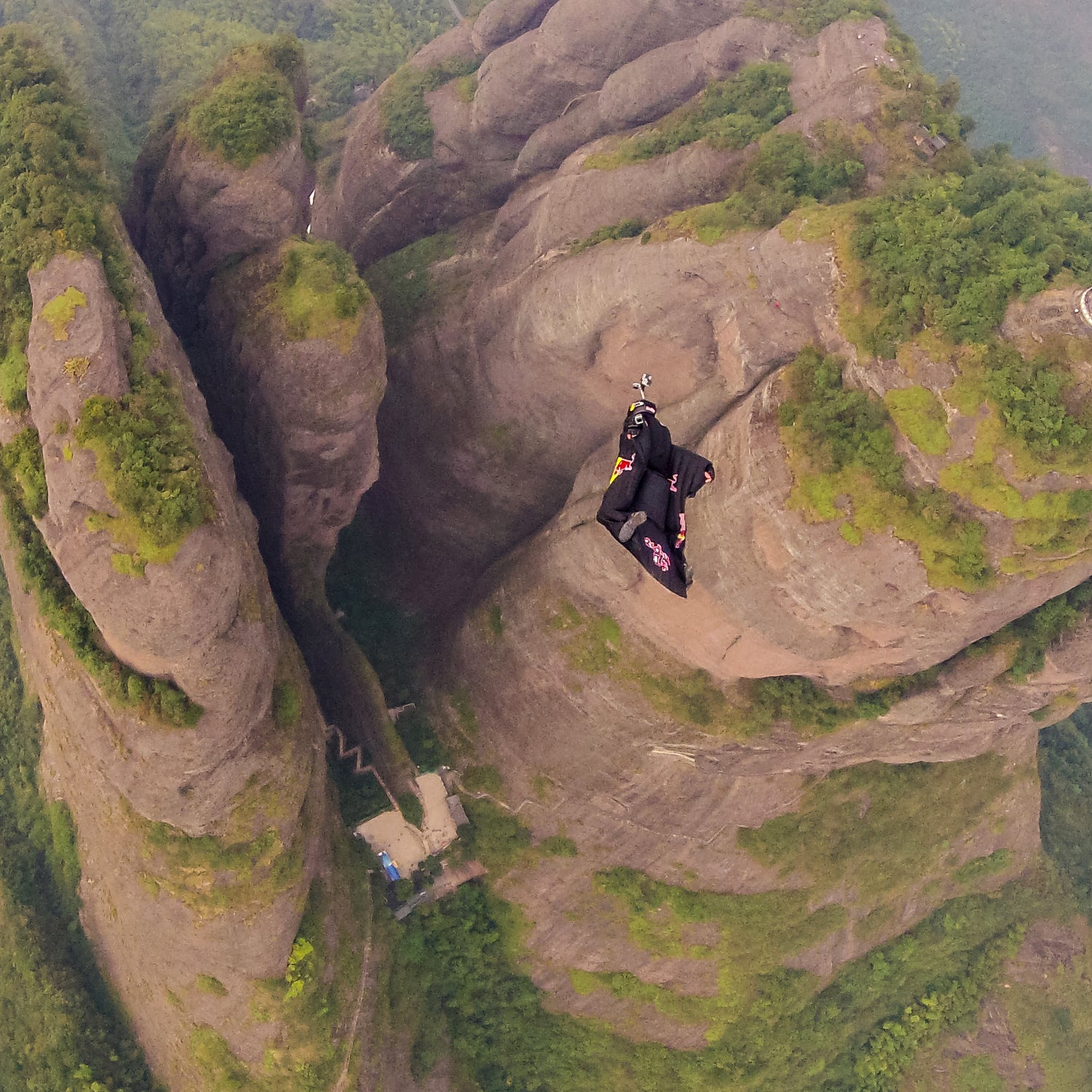In his 18-year BASE jumping and wingsuiting career, 39-year-old American╠²Jeb Corliss has tackled his share of daunting jumps, like the time he on his way down from a Swiss peak. Or the time he . Or the time he .╠²And all╠²of those╠²flights ended well.╠²
But in 2012, after jumping from South Africa's 3,558-foot Table Mountain and flying at about 120 miles an hour, Corliss's left foot clipped a boulder and╠²he crashed into the face of the mountain. Had he not managed to deploy his╠²emergency parachute, a spokesperson ,╠²he would have died.╠²The accident left him with two broken legs and a torn ACL that required reconstructive surgery.╠²Corliss╠²spent more than a year recovering in South Africa.╠²And he doesnŌĆÖt use painkillers (ŌĆ£,ŌĆØ he wrote on Facebook in 2012), ŌĆ£so I got to feel unending, brutal, searing pain for a year of my life,ŌĆØ he says.
He had no plans to stop jumping, though.╠²During his recovery, when an╠²ABC reporter╠²╠²if he would quit the sport, he laughed and said, ŌĆ£ThatŌĆÖs so cute.ŌĆØ╠²At the same time, he acknowledges that such a traumatic accident made him think a lot harder about the risks on which he's built his career. He's always had exacting ideas of which jumps are and aren't possible, but he was even more careful╠²in the months following his recovery.╠²“I impacted flat solid granite at 120 miles per hour╠²and bounced,” he says.╠²“You donŌĆÖt survive something like that. And when you survive an unsurvivable accident, itŌĆÖs not something you forget.”
ŌĆ£My jumping has become 100 percent╠²work for me,ŌĆØ╠²Corliss╠²says.╠²ŌĆ£I now deem the sport to be just too dangerous to do it just for fun.ŌĆØ
So in the spring of 2013, when representatives from Red Bull China asked if he might be interested in scouting a unique objective outside ShanghaiŌĆöa narrow slot on 875-foot Langshan Mountain that Corliss would pilot his wingsuit throughŌĆöCorliss looked at photographs and declined. “The Table Mountain accident was heavy in my mind,” he says.╠²ŌĆ£I thought [the formation] was too small and not high enough.ŌĆØ╠²But when the representatives asked him to come see the formation in person,╠²Corliss agreed to check it out.╠²
The V-shaped slot╠²is╠²60 feet wide at the top but only 15 feet wide at the bottom, extending through the mountain for the length of three football fields. The sliver was stunning for Corliss╠²to examine up close. ŌĆ£IŌĆÖd never seen anything that vertical and that straight for so long,ŌĆØ he says. ŌĆ£I started thinking, this actually could be really cool. I think I could actually do this.ŌĆØ He╠²committed to the stunt on the spot.╠²
The Chinese government granted Red Bull access to the site for an October 2013 live television event. Meanwhile, Iiro Seppanen and Frank Yang of Pan Pacific Productions got to work on a documentary to╠²chronicle Corliss's recovery and╠²the Langshan flight.╠²The╠²resulting 50-minute film, ,╠²was released on Vimeo On Demand at the end of January and allows an intimate look at two defining moments of CorlissŌĆÖs career.
CorlissŌĆÖs preparation leading up to the Langshan stunt did not go as planned. He hoped to have five days of training with up to five jumps per day. But the leftover rain and wind from a recent typhoon made flying too dangerous. Ultimately he got three practice jumps the day before the stunt, but never entered the crack.╠²
Already he was nervous about the numbers involved: He would start his proximity flight through the crack at just 875 feet elevation, an altitude where he would normally deploy his parachute. If he emerged at 300 feet, he would still have time to deploy his chute but a minuscule margin for error when steering toward his landing zoneŌĆöa six-foot-wide platform surrounded by concrete barriers and perched on a cliff. He expected to fall into a stand of╠²trees if anything went wrong, but upon closer inspection, he found that the trees were riddled with dead branches that could impale him.╠²
The bad weather lingered into the event day. It was raining, the mountain was socked in, and the helicopters were grounded. More than 2,000 crew members, including 90 search and rescue staffers,╠²waited alongside thousands of spectators. The event was being broadcast to an estimated 350 million viewers in China, Hong Kong, and Taiwan. With less than a half-hour to go until jump time, the military started to shut down the production. ŌĆ£It was going to be one of the first times I actually failed,ŌĆØ Corliss says. ŌĆ£I felt hopeless.ŌĆØ
Then, inexplicably, the clouds parted and the wind died. The jump was on.╠²But by╠²then╠²Corliss was flashing back to Table Mountain and having second thoughts. He started crying in the helicopter. ŌĆ£This sense of dread and horror took over,ŌĆØ he says.╠²
Then he jumped.
The turbulence from his wingsuit bounced off the narrow walls for╠²a bumpy flight, but Corliss threaded the needle as planned, hitting 122 mph through the crack. He deployed his chute and╠²landed safely.╠²ŌĆ£This was without a doubt╠²the most╠²terrifying thing IŌĆÖve ever done,ŌĆØ he says now.╠²ŌĆ£If someone were to say right now, ŌĆśHey Jeb, weŌĆÖll give you $10 million to do it again,ŌĆÖ IŌĆÖd say no.ŌĆØ
Decide╠²for╠²yourself whether╠²the stunt╠²is a victorious╠²comeback or the type of relentlessly deadly risk-taking that increasingly╠²haunts the sport. Either way,╠²itŌĆÖs enthralling viewing.╠²Seppanen, a former professional BASE jumper and president of the World Wingsuit League who has worked with Corliss before, views the film as CorlissŌĆÖs redemption story. ŌĆ£I think he got a little too cocky for jumping at Table Mountain, and he paid a horrible price,ŌĆØ Seppanen says. ŌĆ£HeŌĆÖs not the same guy who did the jump at Table Mountain.ŌĆØ
Corliss agrees. ŌĆ£My jumping has become 100 percent╠²work for me. I now deem the sport to be just too dangerous to do it just for fun,ŌĆØ he says.╠²ŌĆ£IŌĆÖve watched way too many of my friends die, to go out and jump for the hell of it.”


